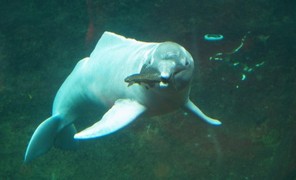Freshwater Animals

Amazon River Dolphin Adaptations:(Inia geoffrensis)
1. The Amazon River Dolphin, or Inia, has an unfused vertebrae in its neck. This gives the Inia the ability to turn its head 180 degrees to either side, giving them greater flexibility to catch prey in flooded forest floors, shallow waters, and tributaries (W12).
2. The Inia has no dorsal fin, only a dorsal ridge. This ride, along with larger flippers, are an adaptation used for swimming and living in shallow river waters (W12).
3. The Amazon River Dolphin has stiff hairs on its beak. These hairs are a sensory organ that help the Inia sense pray in muddy rivers (refer to figure 1) (W12).
Figure #1: The Amazon River Dolphin often has to hunt in dark, dirty waters.
(Image source: http://resources.waza.org/files/images/w(415)h(252)c(1)q(90)/2a3c0b257c49e7346d730e56eb13300c.jpg)
1. The Amazon River Dolphin, or Inia, has an unfused vertebrae in its neck. This gives the Inia the ability to turn its head 180 degrees to either side, giving them greater flexibility to catch prey in flooded forest floors, shallow waters, and tributaries (W12).
2. The Inia has no dorsal fin, only a dorsal ridge. This ride, along with larger flippers, are an adaptation used for swimming and living in shallow river waters (W12).
3. The Amazon River Dolphin has stiff hairs on its beak. These hairs are a sensory organ that help the Inia sense pray in muddy rivers (refer to figure 1) (W12).
Figure #1: The Amazon River Dolphin often has to hunt in dark, dirty waters.
(Image source: http://resources.waza.org/files/images/w(415)h(252)c(1)q(90)/2a3c0b257c49e7346d730e56eb13300c.jpg)

River Otter Adaptations:
( Lutra canadensis)
1. The river otter has a dense layer of fat under it's skin, the otter also has oily skin that protects it in extremely cold weather (W9).
2. The river otter is able to locate food in muddy with it's facial whiskers that are are very sensitive to touch (W9).
3. The otter has many features which make it a great swimmer, some of these include; ears an nose close when it goes underwater, it's eyes are located near the top of it's head so it can see above the surface while it is swimming nearly submerged, the river otter has short legs with five webbed toes on each foot, the otter has tightly packed underfur, and it's long guard hairs are water-repellent (W9).
Figure #1: Various adaptations
have made the river otter a strong swimmer.
(Image Source: http://images.fineartamerica.com/images-medium/river-otter-steve-karol.jpg)
( Lutra canadensis)
1. The river otter has a dense layer of fat under it's skin, the otter also has oily skin that protects it in extremely cold weather (W9).
2. The river otter is able to locate food in muddy with it's facial whiskers that are are very sensitive to touch (W9).
3. The otter has many features which make it a great swimmer, some of these include; ears an nose close when it goes underwater, it's eyes are located near the top of it's head so it can see above the surface while it is swimming nearly submerged, the river otter has short legs with five webbed toes on each foot, the otter has tightly packed underfur, and it's long guard hairs are water-repellent (W9).
Figure #1: Various adaptations
have made the river otter a strong swimmer.
(Image Source: http://images.fineartamerica.com/images-medium/river-otter-steve-karol.jpg)
